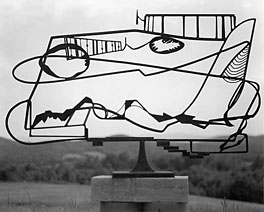
|
ABOVE: David Smith, Hudson River Landscape, 1951. Welded steel, 49 1/2 x 75 x 16 3/4 inches. Whitney Museum of American Art, New York, Purchase.
Photo by David Smith © 2006 The Estate of David Smith/Licensed by VAGA, New York.
|
|
|






Marking the boundaries of this transitional period, as Smith shifted from the use of figurative symbols toward a greater concentration on the terms of sculpture itself, are a group of sculptures he made on the theme of landscape. From 1946 to 1951 Smith made a total of 15 sculptures titled Landscape, as well as at least ten other closely related pieces. He came to this theme through his lifelong preoccupation with the intersections of painting and sculpture: of the established genres in the history of painting, landscape is the one most concerned with the transposition of three-dimensional space into the two-dimensional plane of the painted surface. Many of the artist’s landscape works simulate this picture plane by incorporating a rectangular frame within which smaller sculptural elements interact; in others, various objects lined up along an oblong sculptural base suggest structures standing on a distant horizon.
In 1951 this series culminated with Hudson River Landscape, the largest and most complex of Smith’s landscape works. By this point he had fully adopted his mature “drawing in space” style, and in this piece he came closest to approximating graphic effects in sculptural terms. Here the dominant rectangular frame acts like a blank piece of paper or canvas, upon which steel rods, welded into curves and loops, serve as drawn lines. But still, landscape for Smith was more than a field for formal experimentation; it also appealed to the artist as an expressive motif. Writing in 1947 for an exhibition catalogue, he stated: “I have never looked at a landscape without seeing other landscapes / I have never seen a landscape without visions of things I desire and despise / … a landscape is a still life of Chaldean history / it has faces I do not know / its mountains are always sobbing females / … it is the place I’ve traveled to and never found.”
|